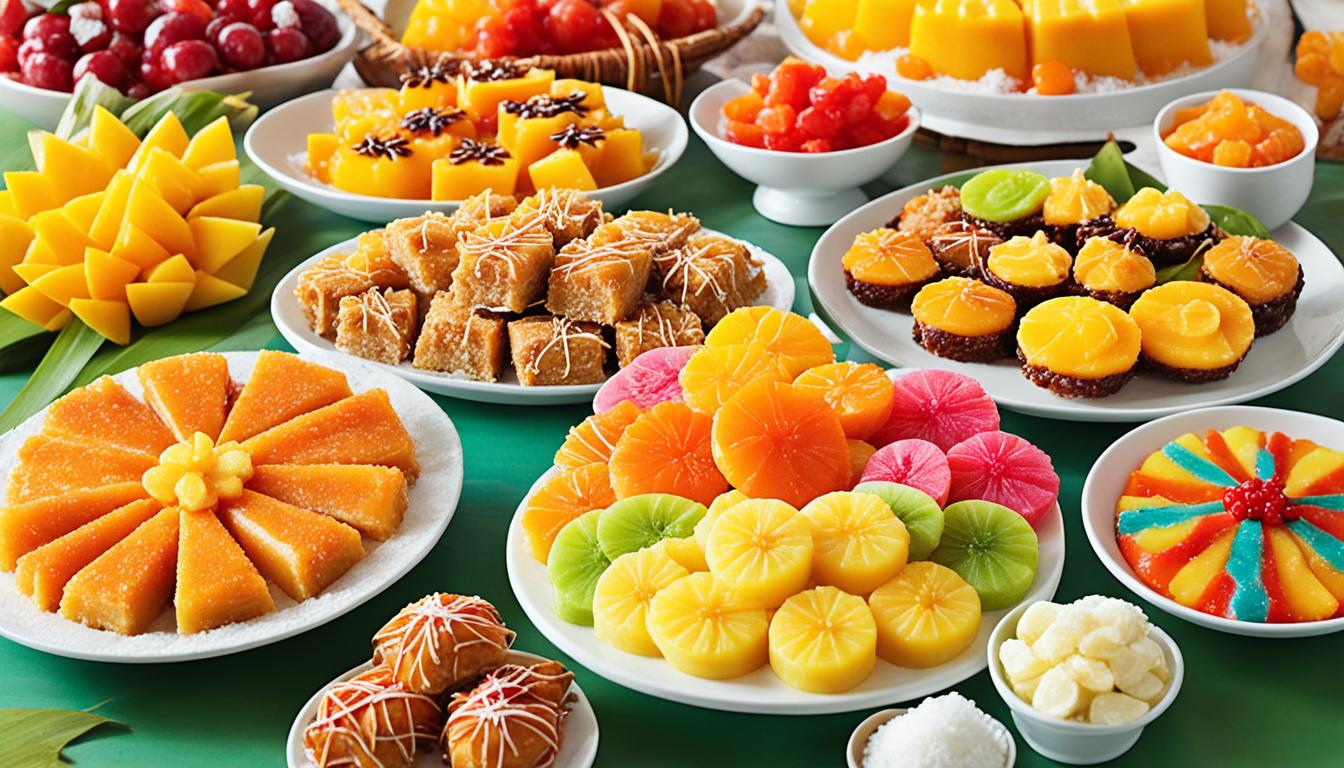When it comes to desserts, the Filipino cuisine has a delightful array of sweet treats waiting to be explored. From traditional favorites that have been passed down through generations to innovative creations that blend indigenous flavors with international influences, Filipino sweets are truly a feast for the senses.
But have you ever wondered how these delectable desserts came to be? How did Filipino dessert culture evolve over time, incorporating a diverse range of ingredients and techniques? And what makes these treats so unique?
Let’s embark on a journey through the world of Filipino sweets and uncover the fascinating stories behind these mouthwatering delights. We’ll discover authentic recipes, learn about the rich dessert traditions that have shaped Filipino culture, and unravel the surprising influences from both European and indigenous flavors.
So, are you ready to satisfy your sweet tooth while immersing yourself in the cultural tapestry of the Philippines? Let’s dive into the tantalizing world of Filipino desserts and discover the flavors that have captivated taste buds for centuries.
Traditional Filipino Desserts with Indigenous Flavors
Traditional Filipino desserts are a delicious reflection of the country’s rich culinary heritage. These sweets celebrate indigenous flavors and ingredients, incorporating them into mouthwatering treats that are enjoyed by Filipinos of all ages.
Suman
One popular traditional Filipino dessert is suman. This rice cake is made by combining glutinous rice with coconut milk, sugar, and local add-ins such as jackfruit, mango, or peanut. The mixture is then wrapped in palm or banana leaves and steamed to perfection. Suman has a delightful sticky texture and a hint of sweetness that pairs well with a cup of hot tea or coffee.
Puto
Puto is another classic Filipino dessert that showcases indigenous flavors. These bite-sized rice cakes are soft, fluffy, and slightly sweet. They are often enjoyed as a snack or served alongside savory stews or soups. Puto can be made with different flavors and colors, such as ube (purple yam) or pandan, adding vibrant hues to the dessert spread.
Champorado
Champorado is a beloved Filipino breakfast dish that doubles as a delectable dessert. It is a chocolate rice porridge made by cooking glutinous rice with cocoa powder or tableya (local chocolate tablets) and sweetened with sugar. Topped with a drizzle of condensed milk or evaporated milk, champorado provides a comforting and indulgent start to the day.
Bibingka
Bibingka is a creamy coconut cake that highlights indigenous flavors. Made with rice flour, coconut milk, eggs, and sugar, bibingka has a soft and moist texture. It is traditionally cooked in clay pots lined with banana leaves and topped with salted egg slices and grated coconut. This delightful dessert is often enjoyed during Christmas season or as part of religious festivals.
Turon
If you’re looking for a unique sweet treat, turon is a must-try. This Filipino dessert is a sweet version of lumpia, the popular savory fried spring rolls. Turon is filled with caramelized bananas or plantains and wrapped in spring roll wrappers. It is then deep-fried until golden and crispy. The combination of sweet, sticky bananas and crunchy wrapper makes turon a delightful dessert or snack option.
Ube and Cassava
Ube, a vibrant purple yam, and cassava, a starchy root, are two key ingredients that add both flavor and visual appeal to traditional Filipino desserts. Ube is often transformed into desserts like ube halaya, a sweet purple yam jam, or used as a filling in pastries. Cassava is commonly used as a base ingredient in sticky cakes, lending a unique texture and taste to these sweet treats.
Traditional Filipino desserts with indigenous flavors are a celebration of the country’s culinary diversity. From the sticky sweetness of suman and puto to the comforting flavors of champorado and bibingka, these desserts are a delightful way to explore the rich tapestry of Filipino cuisine.
European and French Influences on Filipino Desserts
The colonial history of the Philippines has had a profound impact on its dessert culture, with strong influences from Spain and Mexico. These European and French influences have added a touch of elegance and sophistication to traditional Filipino flavors and ingredients.
One example of this influence is pandesal, a popular breakfast bread that resembles a savory dinner roll but is actually sweet. It is a staple in Filipino households and showcases the Spanish and Mexican influence in Filipino baking traditions.
Another delightful treat is ensaimada, a brioche-like sweet bun that is often topped with sugar, coconut, or cheese. Its resemblance to the pan dulce found in Spanish and Mexican bakeries is a testament to the cultural exchange between the Philippines and these European countries.
The famous leche flan, a caramel-topped custard, is reminiscent of the French crème caramel. Its smooth texture and rich flavor are a testament to the French influence on Filipino dessert-making techniques.
Sans rival is a showstopper dessert that consists of layers of nut-meringue with buttercream filling. It takes inspiration from the French dacquoise, highlighting the fusion of Filipino and French culinary traditions.
Meringue-based desserts like silvana and sans rival ice cream sandwiches also exemplify the French influence on Filipino sweets. The light and airy meringue, combined with the indulgent flavors, create a truly unique dessert experience.
These European and French influences have not only enriched the Filipino dessert repertoire but have also become an integral part of the country’s culinary heritage. They continue to be admired and enjoyed by generations, making Filipino desserts a delightful fusion of flavors and cultures.
